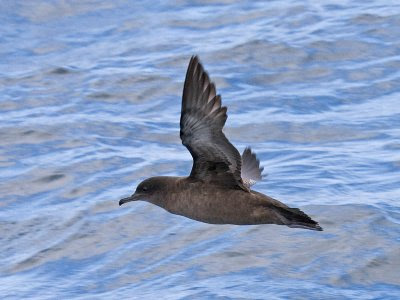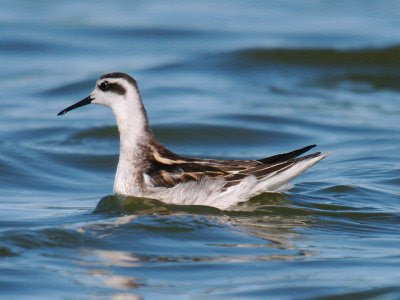 |
| Mottled Petrel. Off Newport, Oregon. December 8, 2012 by Ryan Abe |
Mottled Petrels are one of the Pterodroma or gadfly petrels, known for their occurrence far offshore and their wild arcing flight (see: So you want to see a Murphy's Petrel?). In the low winds this day, however, this bird was not flying in high bounding flight on set wings. Rather it was flying low, fast, and direct with rapid wing beats. The ID of this species is straight forward. The bird is the size of a small gull (kittiwake-sized) with dark belly patch.
 |
| Mottled Petrel. Off Newport, Oregon. December 8, 2012 by Ryan Abe |
Mottled Petrels breed off New Zealand from October-March. The bulk of the post-breeding movement is diagonally northeast directly through the Central Pacific, past Hawaii, in April-May to the Gulf of Alaska and Aleutians, retracing their route back to New Zealand in October.
On the West Coast, presumed failed or non-breeders are found occasionally in February and March, apparently leading the main migratory northward movement by several months. In recent years, birds have been found more regularly in November-December. These are likely young non-breeding birds trailing the main migratory southward movement by a couple of months. This is not unlike the pattern and timing set by Short-tailed Shearwaters. There are additional scattered records throughout the year.
Although there have been a couple sightings from land during storms off the West Coast, most sightings of Mottled Petrels are far from land. Typical are 9 birds 60 miles off the central Oregon coast on 31 March 1981; 3 individual birds 45 miles off the central and northern Oregon coast on 11 December 1990; 1 bird 14 miles off the southern Oregon coast on 13 December 1999; 21 birds from 31 October to 1 November 2005 from 58 to 169 miles offshore Oregon (Oregon Bird Records Committee).
It appears, then, that the "best" time to find Mottled Petrels from Oregon, Washington, or extreme northern California may be the first half of December. My analysis of weather buoy records off central Oregon reveals that only about 25% of pelagic birding trips using chartered sports fishing boats would be successful in early December--the absolute worst time to try to get offshore during the entire year. Nevertheless, this is absolutely the best time of year to see these rare birds off the West Coast.
We'll probably try again next year to charter a pelagic trip in late November or early December to see Mottled Petrels and other winter seabirds such as Laysan and Short-tailed Albatrosses, Short-tailed Shearwaters, Black-legged Kittiwakes, Parakeet Auklets, and Horned Puffins.







































